New Jersey is well-known for many things, including the Statue of Liberty. While Lady Liberty is located in New York, you can get an amazing view of her from Jersey City. In addition, it is also known as the garden state because of all the cranberries, tomatoes, and blueberries it produces. However, there are also many stunning lakes and rivers to explore in this state, some of which are home to some of the most dangerous animals in New Jersey. Some of these lakes include Lake Carnegie, Farrington Lake, Lake Atsion, Monksville Reservoir, Lake Hopatcong, Round Valley Lake, Manasquan Lake, Mercer Lake, Green Pond, Ramapo Lake, Deal Lake, Mohawk Lake, and Merrill Creek Reservoir.
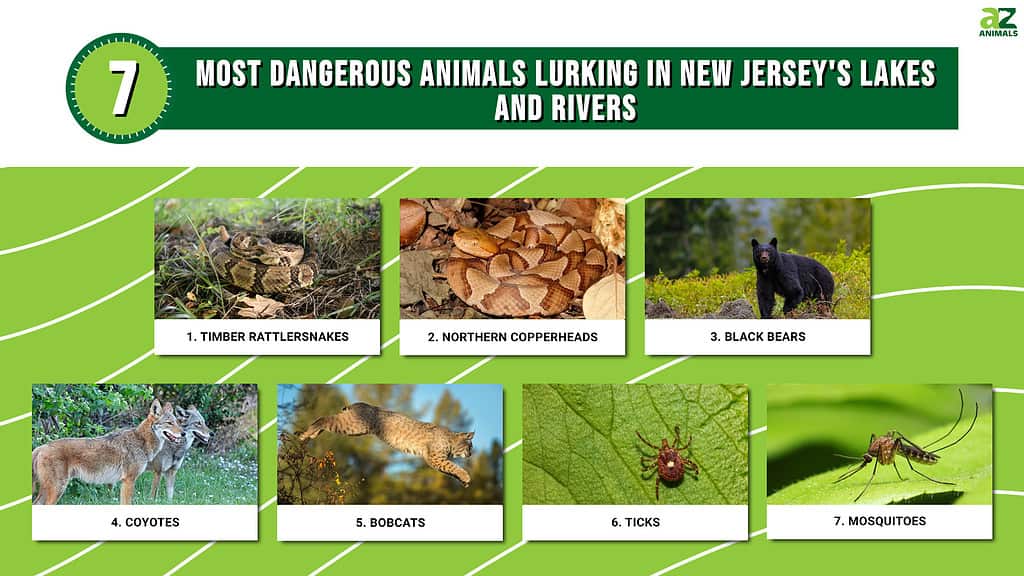
Most Dangerous Animals Found In and Around New Jersey’s Lakes and Rivers
New Jerseys offers visitors many beautiful lakes and rivers to choose from. However, there are some of the most dangerous animals in New Jersey lurking around these lakes and rivers. They include:
- Timber rattler
- Northern copperhead
- Black bears
- Coyotes
- Bobcats
- Ticks
- Mosquitos
1. Timber Rattlesnakes
This snake goes by many names, including timber rattlesnake, black rattlesnake, eastern rattlesnake, American viper, and canebrake. It is a pit viper that occurs in the eastern half of the United States. Furthermore, they are gray with a stripe down their back and often have a pinkish tint. The stripe down their back can be yellow, orange, pinkish, black, or brown. Their tails are made up of loose sections of keratin that form the rattles. If this snake is threatened, it shakes its tail, making a rattling sound to fend off predators. However, the snake will do this as a warning before it strikes. Timber rattlesnake bites are rare, but they are venomous snakes, and their bite can kill humans.
These snakes have large, heavy bodies and can grow up to 7 feet long. They live in various habitats, such as hilly forests, pine forests, river floodplains and swamps, agricultural fields, and lowland cane thickets. Timber rattlesnakes are terrestrial and hibernate in winter. They are amazing climbers and inhabit trees at heights of more than 80 feet. Their diet varies, but they eat rodents, amphibians, lizards, and birds. They will lie and wait to ambush their prey, then strike and wait for the venom to take effect.
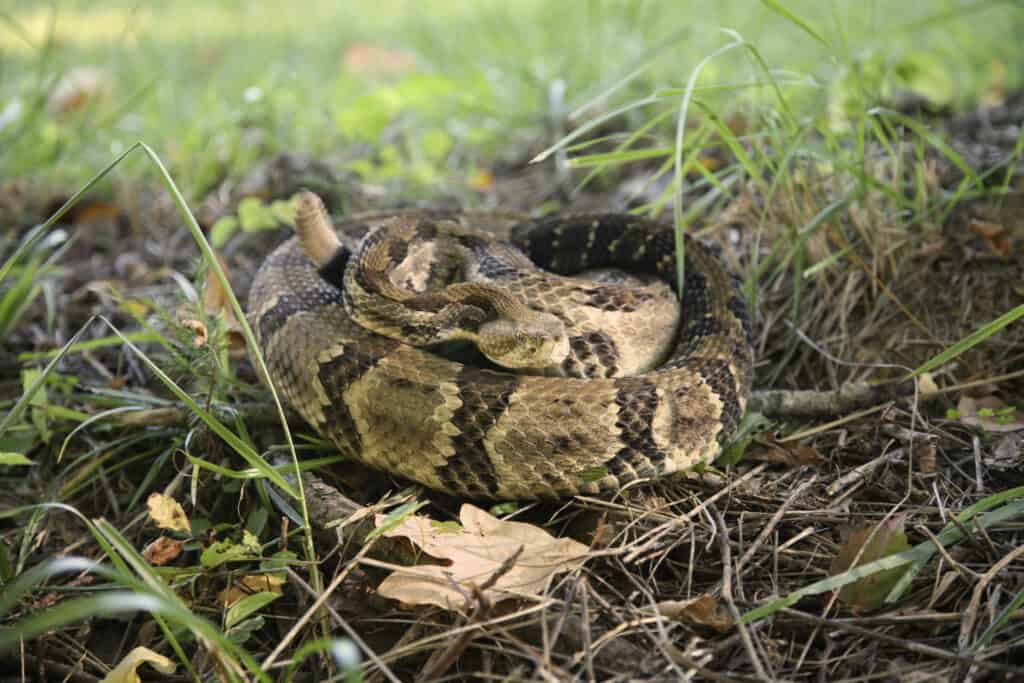
Timber rattlesnake bites are rare, but they are venomous snakes, and their bite can kill humans.
©iStock.com/NajaShots
2. Northern Copperheads
The northern copperhead occurs in semiaquatic and terrestrial habitats across the eastern United States. They are venomous snakes and form part of the pit viper family. This snake is most definitely one of the most dangerous animals in New Jersey.
Copperheads are sturdy snakes with keeled scales. Furthermore, their heads are copper-colored yet unmarked, and have a reddish-brown body. They also have brown crossbands on their bodies. Because they are pit vipers, they have heat-sensitive pit organs between their nostrils and eyes on each side of their heads. This is how they locate their prey. In addition, these snakes can grow up to 36 inches, and the females are generally longer than males.
These snakes occur in many habitats, such as rocky areas, forests, hillsides, and wetlands. You could also find one occupying an abandoned sawdust pile, rotting wood, or even a construction site. Additionally, they are good swimmers and climbers. Copperheads are carnivores and will eat things like mice, small birds, lizards, amphibians, and insects. They will ambush their prey and subdue it with venom before swallowing it whole. If they decide to take on larger prey, they will bite, release the animal, and wait for the venom to take effect before tracking it down.

Copperheads are sturdy snakes with keeled scales. Furthermore, their heads are copper-colored yet unmarked, and have a reddish-brown body.
©iStock.com/David Kenny
3. Black Bears
Interestingly, not all black bears are black. They can also be a rusty cinnamon color or brown. There are even black bears that are blue-gray in color and occur in south-eastern Alaska, called “glacier bears.” In the island archipelago in southern British Columbia, they are white and known as “spirit bears.” However, all these colors are rare, and most are black. But some might have white patches on their chests.
The difference between a black bear and a grizzly bear is that the black bear is normally smaller and darker in color. In addition, they have longer and less rounded ears. Male black bears are much larger than females. Females can weigh up to 200 pounds, whereas males can weigh up to 600 pounds.
These bears occur in North America but are also found in Alaska and Canada. They are not fussy eaters, allowing them to live in various habitats, including forests and along riverbeds.
Black bears are omnivores which means they will eat meat and plants. They have a varied diet, including:
- Berries
- Meat
- Fish
- Insects
- Berries
- Grass
- Larvae
These bears can also kill moose, deer, elk, and sheep. Furthermore, they are very attracted to human food and can become dependent on it.
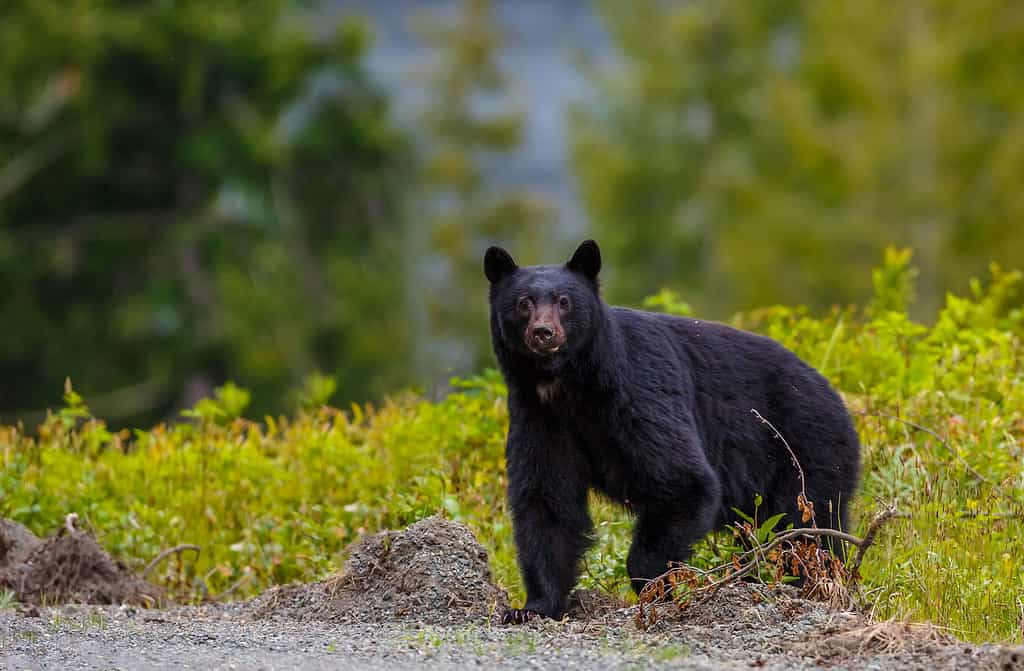
Black bears are omnivores which means they will eat meat and plants.
©Menno Schaefer/Shutterstock.com
4. Coyotes
These clever and cunning animals are part of the dog family. They occur in a wide area from Alaska to Central America. They also like to live near people at the edges of cities and are known for their night-time howling. Coyotes often get compared to wolves but are smaller and weigh less. For example, they can weigh between 20 – 50 pounds. They have long, thick fur, which is mostly grayish-brown with white on their throat and underside. Also, they have bushy tails with black tips.
Coyotes are nocturnal and, therefore, mostly hunt at night. They will normally hunt alone, but groups of coyotes are called a pack. Their diet primarily consists of sheep, small mammals, and rodents, but they will also eat plants and dead animals. Packs of coyotes will communicate with each other through yaps, howls, and barks.
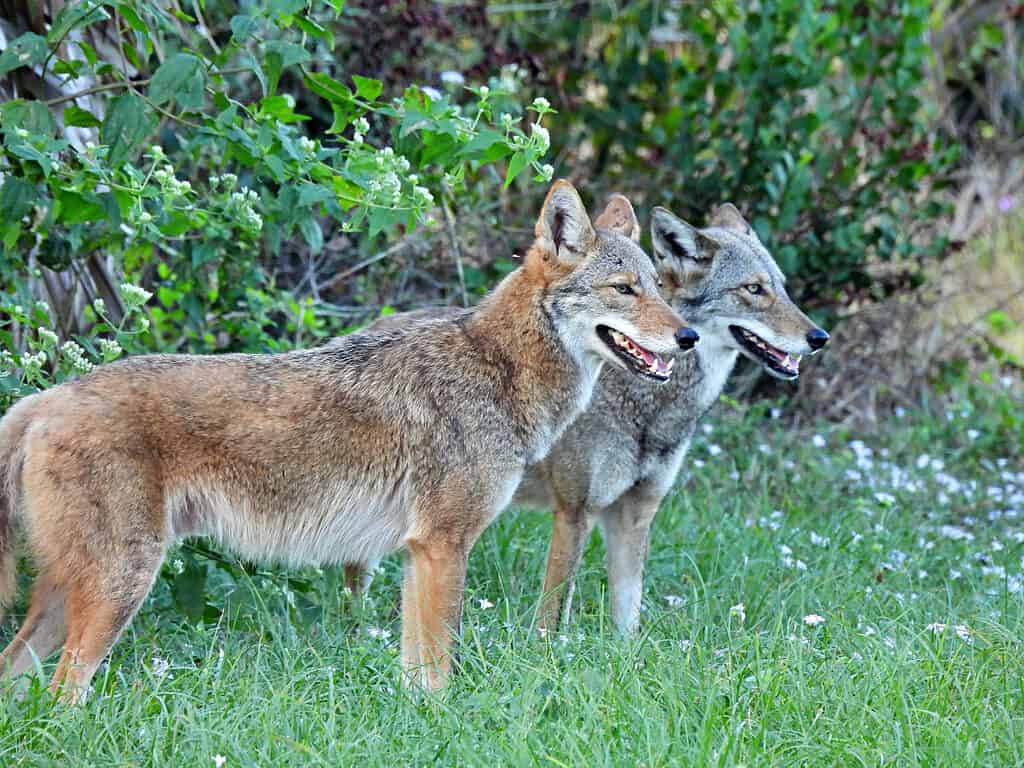
Coyotes are nocturnal and, therefore, mostly hunt at night.
©iStock.com/passion4nature
5. Bobcats
This cat inhabits most of North America and occurs in mountains, forests, swamps, and deserts. Bobcats are mostly nocturnal but are most active at dusk and dawn. Furthermore, they spend their days in their dens. Bobcats are very good swimmers and climbers and have a lifespan of between 10 to 14 years. They are also closely related to lynxes and have retractable claws, spotted coats, and short, big ears. They get their name from their short stubby tails that look like it has been chopped off.
Bobcats are carnivores, but their prey varies by habitat and what is available. They usually hunt alone and eat animals such as hares, rodents, rabbits, weasels, birds, fish, and sometimes small deer. They will stalk their prey and pounce on it.

Bobcats are carnivores, but their prey varies by habitat and what is available.
©Chris Desborough/Shutterstock.com
6. Ticks
Many people are unaware that ticks and mosquitos can be very dangerous to humans. There are more than 200 species of ticks in the United States. They can primarily inhabit shrubs and tall grass. Ticks do not jump or fly but follow their hosts until they can climb onto them or drop from trees or other structures.
These small creatures can live for up to 200 days without water or food and have a lifespan of two months to two years. These arachnids are top of the list of annoying pests. They survive by drinking the blood of small animals, birds, pets, and humans. Furthermore, some species are responsible for tick bite fever which can be serious for humans if not treated.
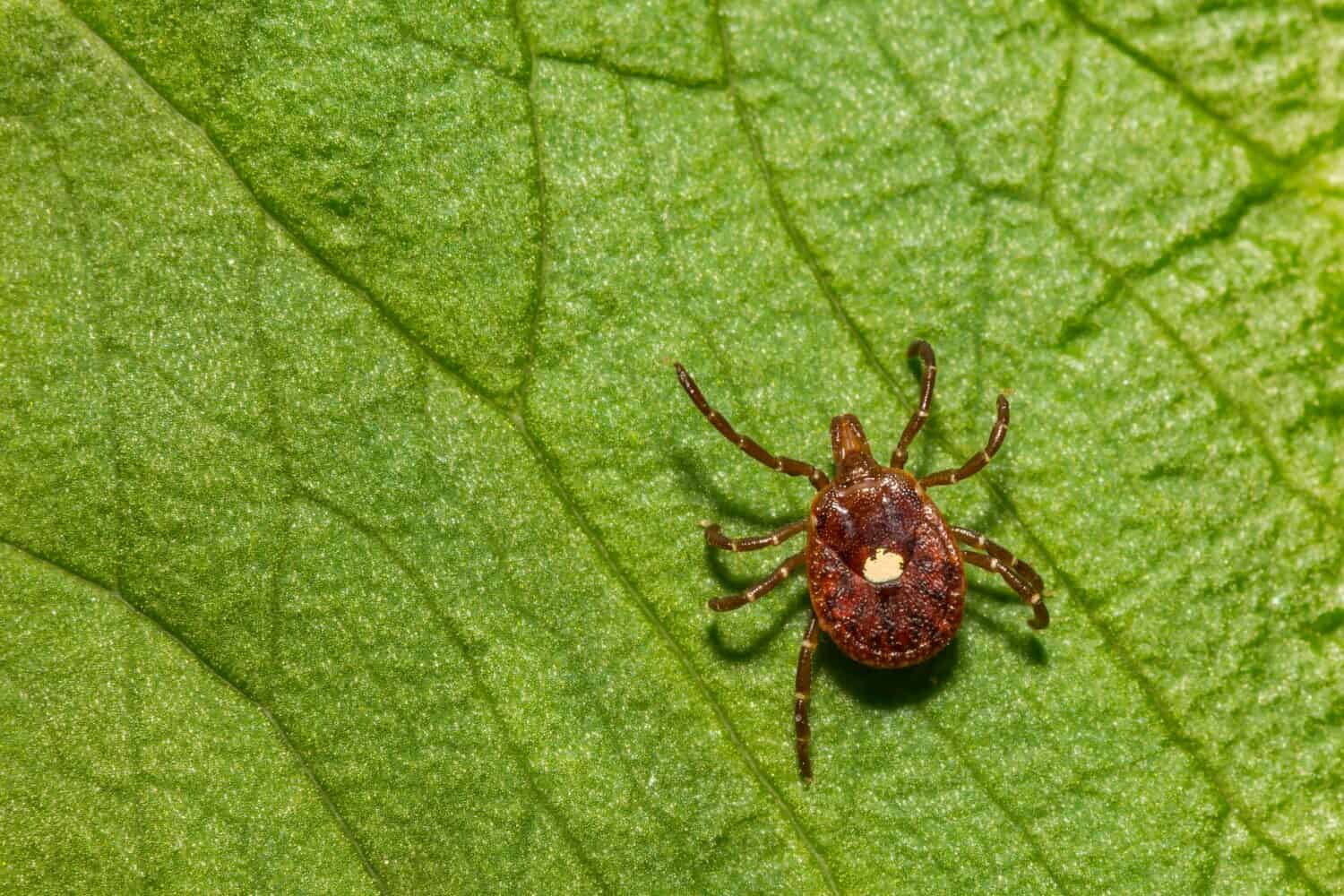
These small creatures can live for up to 200 days without water or food and have a lifespan of two months to two years.
Image: Jay Ondreicka, Shutterstock
©Jay Ondreicka/Shutterstock.com
7. Mosquitoes
Mosquitoes are one of the most dangerous animals in New Jersey. There are about 170 species of mosquitoes in North America. These pests survive on plant nectar and blood. Only female mosquitoes target humans; males only survive on plant nectar. Mosquitoes are considered summer pests and are most active at night. Furthermore, they can detect body heat and the carbon dioxide that humans breathe out. They will breed in moist, soft soil and stagnant water. Mosquitos spread diseases such as dengue fever, West Nile Virus, and malaria, which are all very serious when contracted by humans.
Some prevention includes:
- Don’t leave rubbish near standing water.
- Try not to be outdoors at night.
- Don’t leave water standing anywhere for longer than a week.
- Have screens over doors, windows, and other openings.
- Use a good insect repellent.
- If sleeping outdoors, use a mosquito net.

Only female mosquitoes target humans; males only survive on plant nectar.
©jiade/Shutterstock.com
Summary of the 7 Most Dangerous Animals Lurking in New Jersey’s Lakes and Rivers
| Number | Animal |
|---|---|
| 1 | Timber Rattlersnakes |
| 2 | Northern Copperheads |
| 3 | Black Bears |
| 4 | Coyotes |
| 5 | Bobcats |
| 6 | Ticks |
| 7 | Mosquitoes |
The photo featured at the top of this post is © Skynteef/Shutterstock.com
Thank you for reading! Have some feedback for us? Contact the AZ Animals editorial team.






